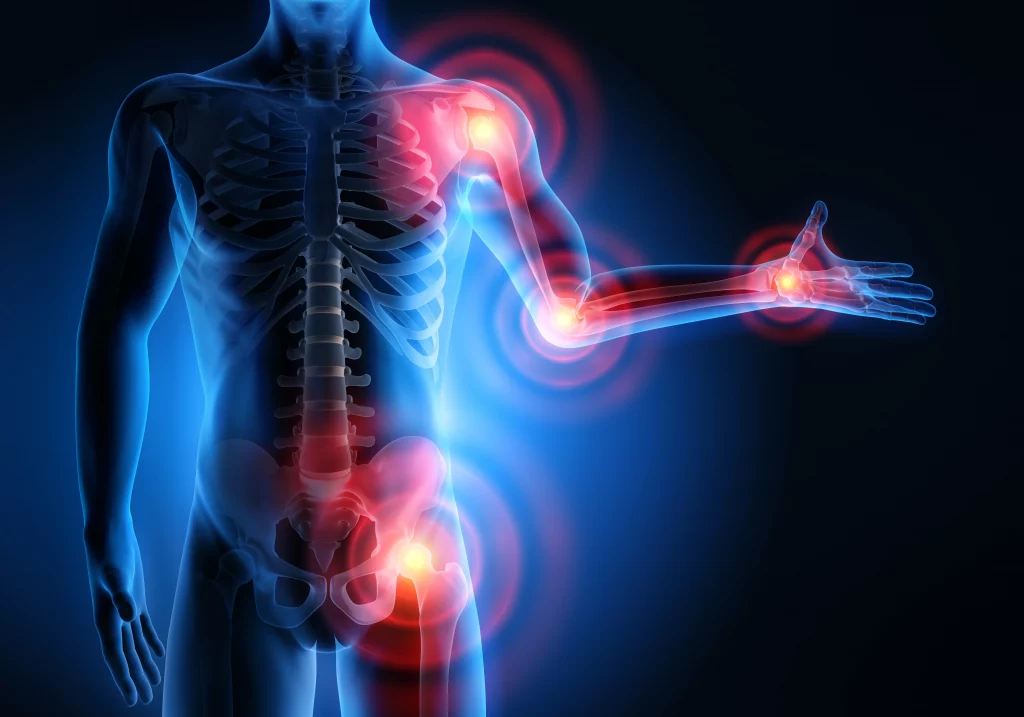
This condition, also known as degenerate arthritic or degenerative joint disease, also includes the degradation of articular cartilage and subchondral bone.
Symptoms of osteoarthritis include joint pain, stiffness, and locking. Tenderness, changes in joint shape, as well as effusion — which is swelling that results from excess fluid in the joints — are often symptoms of osteoarthritis as well. In severe cases of osteoarthritis, the bone surfaces become more exposed as the cartilage degraded, thus damaging the bones. While pain is the primary symptom of osteoarthritis, a loss of mobility is often a result of the aforementioned pain. Mobility and degradation have an inverse relationship when it comes to osteoarthritis. As mobility lessons, the risk of regional muscle apathy and ligament deterioration greatens.
Who develops osteoarthritis?
There are a variety of populations at risk for osteoarthritis. The elderly are particularly vulnerable to osteoarthritis, with the condition rarely occurring in people under the age of 40. By the age of 55, at least 80% of people have some evidence of osteoarthritis. However, even when examinations like x-ray imaging point to osteoarthritis, you may not experience joint pain or other symptoms of osteoarthritis.
Behind age, gender and obesity are major contributors to your likelihood of developing osteoarthritis. Men are two- to three-times more likely to develop osteoarthritis than women are. To make matters worse, if you are a woman, you are more likely to experience joint pain if osteoarthritis does in fact develop. Those who are obese have a predisposition to osteoarthritis, and pain may be heightened by excess weight pressing upon joints.
Lifestyle habits contribute to the likelihood of developing obesity. People with occupations that include amply squatting and kneeling — like construction, carpentry, and professions that require extensive standing and walking — are more likely to develop osteoarthritis, as are people who have experienced substantial joint injury and/or trauma. Lastly, athletes who participate in certain sports — including football, cycling, gymnastics, and soccer — have a higher likelihood of developing osteoarthritis.
Could stem cell therapy help my osteoarthritis?
If you’re experiencing osteoarthritis, stem cell therapy may be a viable treatment option. Stem cell therapy has been useful for multiple types of arthritis, including osteoarthritis. The stem cells used to treat osteoarthritis usually come from umbilical cords, particularly because cell rejection is less likely with the mesenchymal cells from umbilical cords. Bone marrow is an effective source of mesenchymal cells as well and is often used in place of umbilical cord cells when umbilical cord cells are not available. It is also possible to take stem cells from fat tissues and blood.
Stem cell therapy for osteoarthritis includes injections into the sites of inflammation. This route of osteoarthritis treatment may be used in conjunction with or in lieu of surgery to remove loose cartilage, repair tears, and smooth bone surfaces. Other surgical procedures include joint fusion — which eliminates the joint entirely — and osteotomy, which is a surgery typically undergone by younger people to increase stability in knee and hip joints. In the worst cases of osteoarthritis, joint replacement may be recommended by your physician. However, stem cell injections at the osteoarthritis sites may be an effective line of defense before such drastic surgical action is taken.
While research isn’t unanimous as to whether stem cell injection directly reduces inflammation or releases substances that indirectly improve other cells, the research does point to the injections lessening the symptoms of osteoarthritis with a significant amount of efficacy. Research also suggests that stem cell injections can thicken and regenerate cartilage that has been worn down as a result of osteoarthritis.
The goal of stem cell therapy for osteoarthritis is to reduce pain, prevent inflammation, and in some cases promote healing and reversal of symptoms. Osteoarthritis has most commonly been both researched and treated in the knees, although clinics can treat joints throughout your body.
As with all applications of stem cell therapies, the application for osteoarthritis is steadily increasing and the results look promising. If you’re looking to reduce and potentially reverse the symptoms of osteoarthritis — and simultaneously improve your quality of life — stem cell therapy might be a smart option for you.

